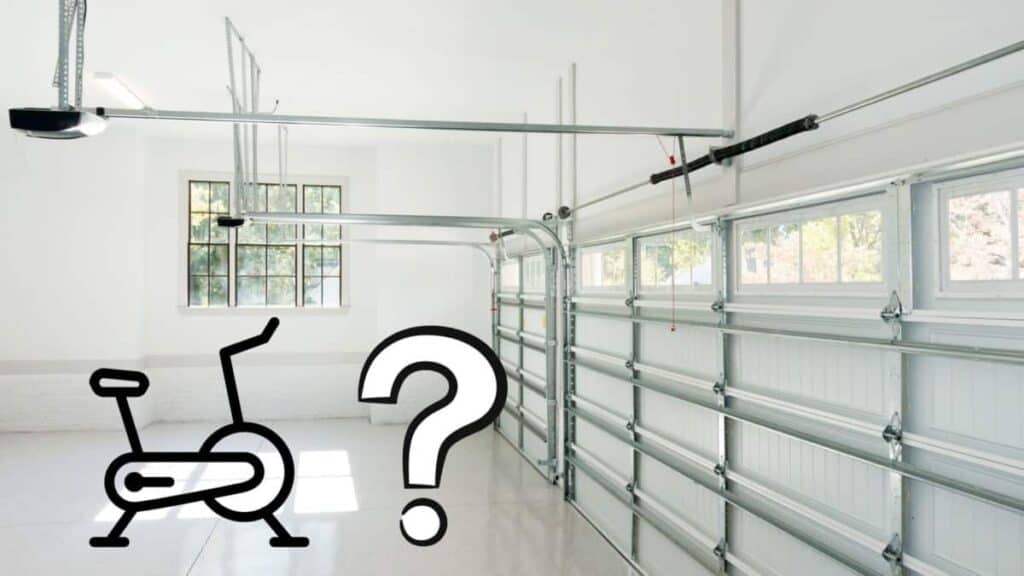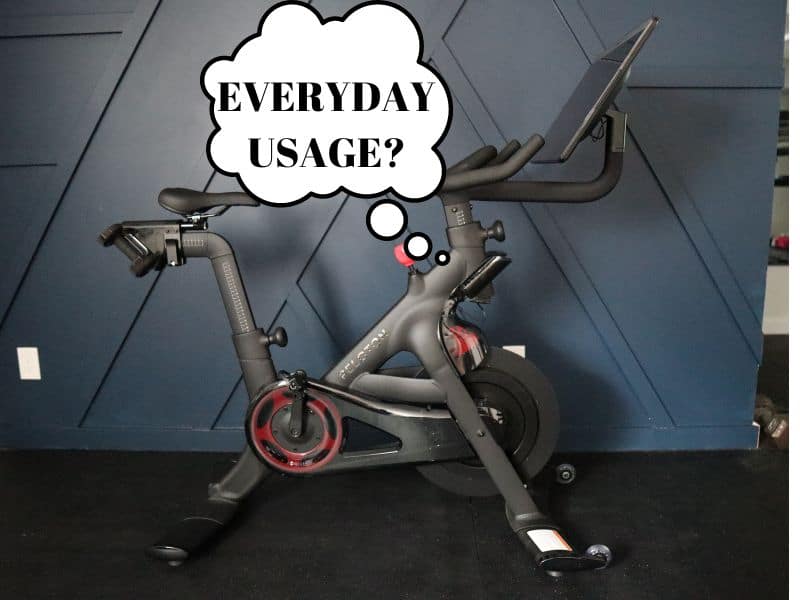The Peloton Tread and Tread+ are revolutionary treadmill designs from Peloton. The convenience of having a “live” trainer in the comfort of your home, fitting into your personal schedule, is remarkable. But the Tread is a heavy device, just like most treadmills, and you don’t want it to damage your floor. So, what type of flooring should the Peloton Tread or Tread+ go on?
The weight of the Tread and Tread+ ranges from 290 to 430 pounds, making the treadmills heavy machines that should go on hard, flat, stable floors such as polyurethane flooring. It is not recommended to put them on carpet or flooring that can easily be damaged/interfere with the incline mechanisms.
There are several aspects to keep in mind when it comes to where you put your Peloton Tread, even more than with regular treadmills. The Tread is a heavy and extensive piece of precision machinery, and making the wrong choice could result in floor damage, equipment failure, or even bodily harm. Let’s take the time to evaluate the best flooring options for your Peloton Tread or Tread+.
What Type Of Flooring is Best For The Peloton Tread
This might be the best starting point: looking at the types of flooring that you should use to put your Peloton Tread or Tread+ on. According to Peloton’s website, the Tread and Tread+ should go on hard, flat, and stable floors. Those are the three primary factors that we will use to compare the different flooring options that you may have in your home.
1. Rubber Top Foam Exercise Gym Mats
These gym mats are most commonly used for the flooring in commercial gyms. The rubber top is hard and stiff while still being slightly flexible and springy. The mats can absorb sudden bumps and heavy weight without taking too much damage.
Having your Peloton Tread or Tread+ on a rubber top foam mat will ensure that the weight won’t damage the floor. Generally, the flooring won’t stick out and damage the mechanical components inside the treadmill.
However, a side note is that these mats will only be as flat as the surface underneath. You will have to ensure that the floor is flat and level enough so it can handle the Tread properly.
These are the mats that we recommend for the Peloton Tread and Tread+.

2. EPDM Rubber Matting
EPDM is a blend of rubber that is very stiff with excellent durability and wear resistance. Covering your floor with EPDM is sure to give you flooring for your Peloton Tread that will last for years and years.
Rubber is known for its flexibility, which is vital since it will very effectively absorb the impact and momentum of the machine and your feet hitting the treadmill. But EPDM is much harder than ordinary rubber, meaning that the legs of the Peloton Tread won’t dent, scratch, or damage the flooring in any other way.
The same drawback applies to EPDM: if the floor underneath is uneven, your flooring will be uneven, and that will cause problems with your Peloton Tread.

3. Vinyl Flooring

Another material commonly used for gym flooring is vinyl. Like the rubber top foam mats, it is strong hard with just enough springiness to effectively absorb bumps, movements, and heavy weights.
The main difference between vinyl and the gym mats is that vinyl is much better at handling moisture. The gym mats may eventually start to crumble and break apart if it’s exposed to too much moisture. This will not happen with vinyl.
The chances are that your flooring won’t be exposed to moisture too much; only the condensation from your water bottle, some water when you’re cleaning the floors, and maybe a few drops of sweat here and there if you’re doing it right. But still, in the long run, all that moisture will have a negative effect on the gym mats, while your vinyl flooring will still be in tip top shape.
There are two main drawbacks to vinyl flooring, though. The first is the same as for rubber top gym mats: if the floor underneath is uneven, it will affect the vinyl as well. The other matter is that, for the most part, vinyl flooring is more expensive than gym mats. But it is worth the expense to know without a doubt that you have a good, reliable floor for your workouts.
4. Plain Cement Or Concrete Flooring
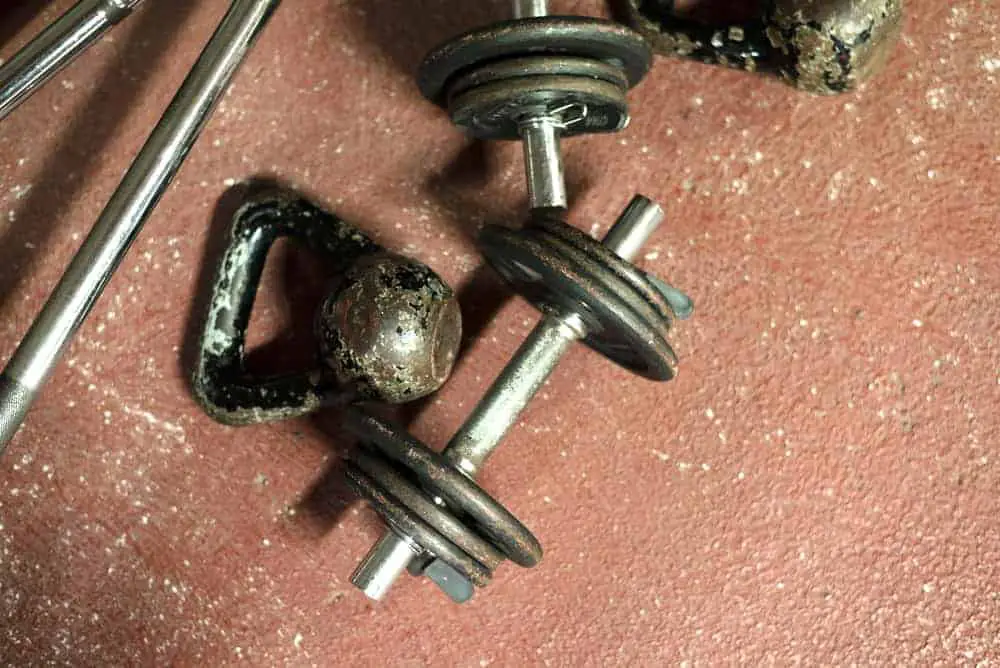
This is a good option that’s also affordable since most of us already have it somewhere in our homes. Cement is usually the type of flooring found underneath carpets or hardwood. The cement is covered up to make it look better or to improve temperature control inside our home, but the chances are that there’s a cement floor somewhere underneath your feet.
When we look at Peloton’s requirements regarding the flooring for the Tread and Tread+, cement already has the first point down: stable. Cement is about as stable as you can get since the cement flooring is usually poured directly onto the foundation of your house.
In a multi-story building, the upper floors are usually also made of cement that is poured or shaped into a mold supported by beams and pillars that are strategically located to accomplish even weight distribution of the floor above it. You can’t get much more stable than cement due to how cement flooring is integrated with the foundation of the building.
Cement is also hard. You get different types, and the mixture will determine how hard it gets. Sometimes cement is mixed with kinds of sand. This can make it brittle, causing the cement to break or chip easily. That type of cement is not ideal since the repetitive motion and weight of the Peloton Tread will cause damage to the floor.
Harder types of cement tend to have a smoother appearance. If your cement floor has that smooth, almost polished appearance, you will struggle to find better flooring for your Tread.
The other important factor is that the floor must be flat. Cement does not guarantee this since cement is often poured in a liquid form. The builders responsible for the floor will determine how flat the surface is. But on any cement floor, you can often find a level and flat part to fit your Peloton.
There are two potential drawbacks to cement flooring. The first is that cement has no noise-dampening properties. The Peloton Tread is not nearly as loud as many other treadmills are, but it’s definitely not silent. If you put your Tread on a cement surface, all the noise from the mechanical parts will be reflected back from the floor, making your workout louder than it should be.
The other negative side to cement is that it can get cold. Most of us have cement flooring in our garages, and that’s also one of the more popular places to keep a treadmill. The problem is that a garage, especially with a cement floor, can get very cold, and cold is an enemy of mechanical components. It could cause faster wear and tear on your treadmill.
5. Floor Tiles

Yes, floor tiles break or chip easily and are not often seen as the ideal flooring for any heavy equipment. Some tiles can also be scratched by even slight movement over their surface. But if you have the right floor tiles and they are correctly fitted, tiles can make excellent flooring for a Peloton Tread or Tread+.
There are a few prominent factors to keep in mind when it comes to floor tiles:
- Don’t go cheap. Cheaper tiles are less sturdy and could chip or break easily. Buy something a little bit more expensive; at least that way, you’ll know that you won’t have to replace the tiles any time soon.
- Don’t put the treadmill on tiles that are “pretty.” Nicely decorated tiles can scratch and damage easily, and there’s no point having anything beautiful underneath your treadmill anyway.
- Make sure that they are correctly fitted. Most people will look at a cement floor and think, “I’m sure I can fit those tiles myself.” It’s not that simple or easy. The tiles have to be perfectly level and even to keep your Peloton Tread stable.
- The tile cement underneath must also be distributed evenly so that there are no hollow points under the tiles since these “air pockets” could cause the tiles above them to break if too much pressure is applied from the top by something heavy, like a Peloton Tread.
- The area between the tiles must be adequately filled with grout; otherwise, the Peloton’s legs may get stuck in the grooves, causing unstable functioning and possibly even causing the legs to break off.
If you follow these guidelines, there’s no reason not to put your Peloton Tread or Tread+ on floor tiles. Yes, the Peloton is heavy, and most floor tiles are not designed to handle that kind of weight. But Peloton put a lot of effort into ensuring that the weight is evenly distributed, meaning that no one tile will have to take all the strain of the whole treadmill.
6. Bricks Or Paving
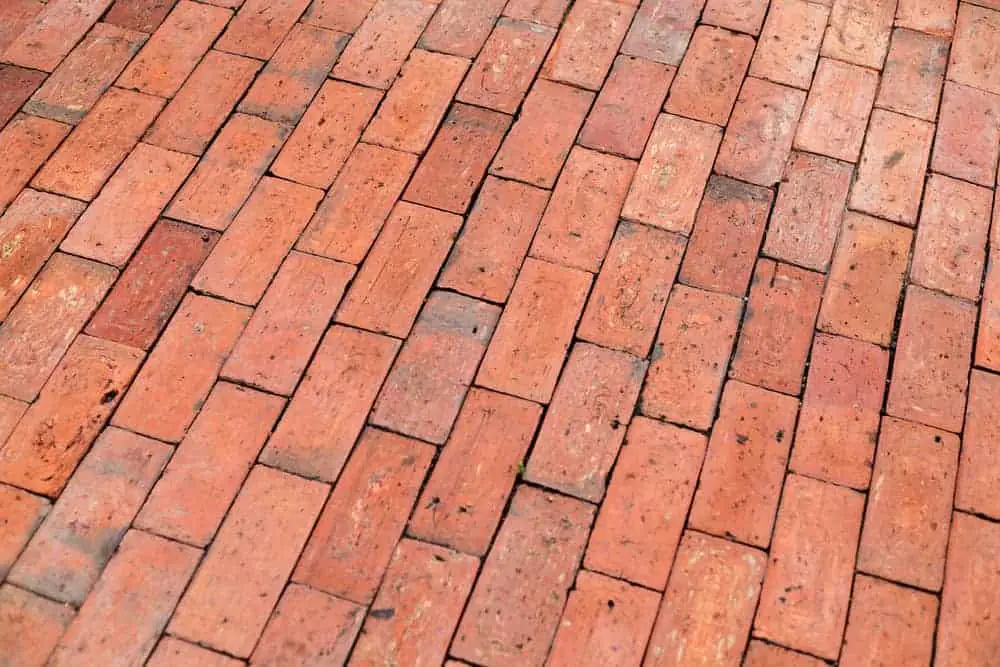
Bricks are designed and manufactured to be strong, stable, and relatively flat. Since they are the primary building blocks of modern homes and buildings, they are designed to carry large amounts of weight without chipping or breaking. With the even distribution of weight inside the Peloton Tread, no one brick will have to take all of the weight either way.
When it comes to bricks, the same rules apply as with tiles. You have to ensure that the bricks are laid evenly, that the surface is as flat as possible, and that there are no spaces between or underneath the bricks. Once you have all of that covered, then brick flooring should be perfect for your Peloton Tread or Tread+.
Flooring That’s Not Ideal For The Peloton Tread
So now we know what kinds of flooring are ideal for the Peloton Tread and Tread+; let’s see what types of flooring to avoid.Most of us only have a few options available since we don’t want our treadmill to stand in certain parts of our homes, like the kitchen or the bathroom (places that usually have hard floors). Choosing the right spot is crucial so as not to do any damage.
1. Soft Wood Flooring
Wooden floors look beautiful. A floor covered with polished or varnished wood can make a room look stylish or rustic or add a classic touch to your home. Things that don’t look good are scratch marks and dents from your $4,000 treadmill that you placed on that beautiful wooden floor.
Some wooden floors are more solid and don’t scratch or dent so easily. Soft wood or wooden laminating is probably the worst option to put your Peloton Tread on since they damage like nothing, and a 400-pound machine will surely ruin that beautiful floor forever.
Hardwood floors are more difficult to damage, but it’s still not impossible. The constant weight of the treadmill, combined with the frequent momentum and additional weight of the user, will have an impact sooner or later, and repairing or replacing the floors could be even more expensive than your treadmill was. It’s simply not worth it.
2. Laminated Flooring
Laminated flooring is another no-no. The laminating that covers the floor is soft, easy to scratch or dent, and sometimes even easy to tear or peel off if enough force is applied. Four hundred pounds being moved around on the floor regularly is more than enough force to permanently damage any type of laminated flooring.
3. Carpets, Especially High Pile Carpets
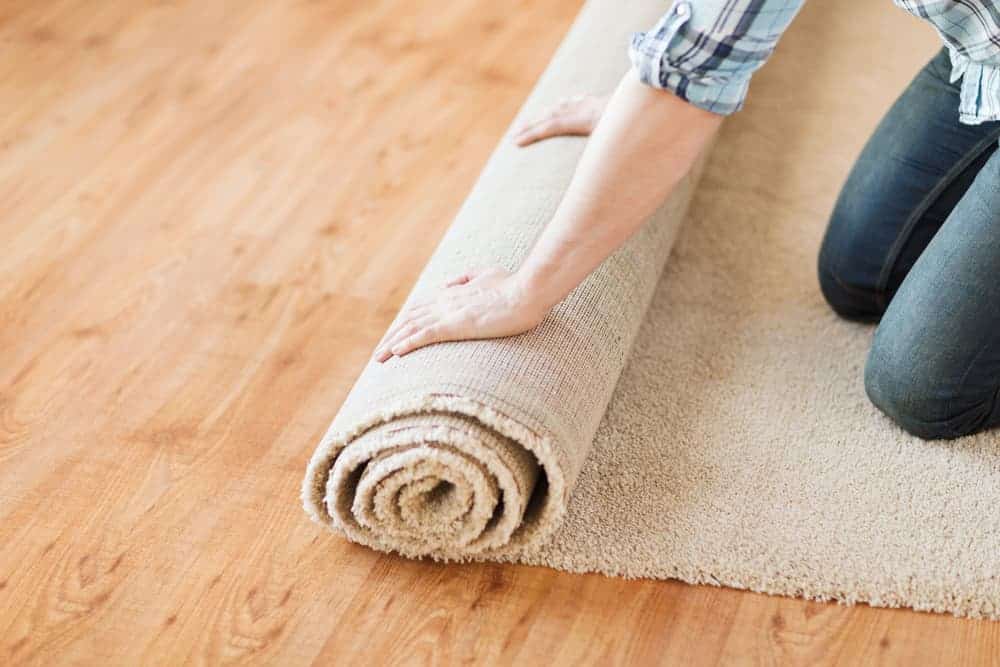
There are two reasons for avoiding carpets when you place your Peloton Tread or Tread+. The first applies to any type of carpet, and that’s the fact that carpets are also a soft flooring option. You’ve seen what ordinary furniture can do to carpets when they’re left in one position for too long. Now imagine what the heavy Peloton Tread will do to your carpet?
You won’t want to move the treadmill too often, either. It’s challenging to move around, so it’s much easier just to position it in the right place and leave it there. That means your carpet will never get breathing space, and the Peloton Tread will leave lasting dents on the floor, not to mention the possibility of the repeated motion ripping or tearing the carpet.
Another reason to avoid carpets when placing your Peloton Tread is that high pile carpets can quickly get stuck in the treadmill’s incline mechanisms. This can cause damage to your Peloton Tread that could cause a fortune to repair, not to mention the possibility that you could be injured by the sudden jerking halt of the treadmill as its machinery starts to fail.
One last reason why carpets are not ideal for a treadmill is that they are naturally full of fibers. These fibers loosen or break with the movement on top of them. Since the treadmill has many mechanical parts moving around just a few inches above the carpet, the loose fibers will naturally be sucked up into the mechanisms.
This won’t cause significant problems immediately, but over time it will cause wear and tear, jam into gears, absorb lubrication, and cause large-scale havoc. So, all in all, it’s safe to say that carpet is also not an excellent option to have under your Peloton Tread or Tread+.
4. Slate Stone Floors
Slate and other stone types commonly used for flooring can be both uneven and brittle. Having your Peloton Tread on an uneven floor will cause instability in its functioning, as we will see later. But brittle stone floors can damage and break easily from too much weight and strain placed on them. The same applies to some types of tiles, though floor tiles are made to withstand the weight.
Apart from that, stone floors need regular care and polishing, so putting something heavy on there that you may have to move at least once a week is not a good idea.
5. Any Uneven Flooring
The Peloton Tread and Tread+ both have adjustable feet. That does not mean that it’s a good idea to put the treadmill on an uneven floor, though.
For one thing, only the back feet of the Tread is adjustable. So that’s great, but if the front of the Peloton is uneven, it could still lead to instability while operating the device. Remember that the Peloton Tread depends on many rapidly-moving mechanical parts to do its job, and then the added weight of the user exerts more force. This momentum can cause damage to mechanical components.
There have also been reports of the Tread (not the Tread+) having problems with the bay that holds the LCD screen, causing the screen to fall and sometimes break while it’s in operation. Peloton recalled the Tread at one point to fix this problem, but the fact remains that any unstable operation is a bad idea.
6. The Second Floor Of Your House
To be clear, this is not a rule that’s carved in stone, and there are exceptions. But it is something to take note of. According to Peloton, the Tread and Tread+ are both safe to use on the upper floors of a building if the building is built to a certified standard.
Many houses have loft areas with simple wooden plank flooring and very little support. They are made for general furniture, and the floors can easily handle some people walking around. But the moment you add a 400+ pound fast-moving device with someone running on it to that equation, the picture becomes very different.
Also, a treadmill on the second floor can be very noisy for those using the lower levels, keep this in mind before deciding to put the Tread on an upper level.
If you want to use your Peloton Tread or Tread+ on the upper floors of a building, first make sure that the floors are correctly built with adequate support in place. You don’t want to come tumbling down mid-workout.
Solutions If Your Flooring Isn’t Perfect
If you don’t have the perfect flooring solution for your Peloton Tread or Tread+, don’t fret. There are two possible solutions to your problems.
Adjust Your Peloton Tread’s Feet
So you’ve looked around your house and found the perfect spot for your brand new Peloton Tread. There is a window view, enough space around you to let you move and breathe, and proper ventilation. Even the floor is perfect; it’s stable, hard, and even. So the Peloton is put in place, and you get on top to start your workout. But to your dismay, there’s a wobble.
This is a common problem. Most floors, if not all, have some slightly uneven spots here and there. As long as it’s just a slight unevenness, you can quickly solve the problem by adjusting the back legs of the Tread. Note that the front legs are not adjustable, so ensure that the front is stable before adjusting the back. Then you simply follow these steps:
- Adjust the incline of the Tread or Tread+ to zero and rest both front feet on the floor.
- Look at the rear of the Tread, and you should see that one of the back legs isn’t touching the floor.
- Use a 27mm wrench to loosen the nut above the foot that doesn’t touch the floor.
- Now turn the foot. Turning it clockwise will lower it, and counterclockwise will raise it. Adjust it until both feet touch the floor sturdily and there’s no more wobble.
- Now tighten the nut again to lock it into place.
- You should test the Peloton at the minimum and maximum incline to ensure that it’s perfect, and re-adjust if you find any further problems.
Use A Treadmill Mat
Many types of flooring will never be perfect. There are homes where every part of the floor is either wood or carpet, neither of which are ideal flooring options for your Peloton Tread. Some people have started using yoga mats to put underneath their treadmills, and though this is a workable solution, a yoga mat is not made for that kind of weight or strain, and it will eventually break.
For that reason, some companies manufacture specific treadmill mats. These mats are made of either PVC foam, rubberized vinyl, or rubber interlocking squares (often found in gyms). They are manufactured to be durable and strong, to absorb the weight and impact of the treadmill, and they will usually even absorb the noise from the treadmill as well.
These treadmill mats protect the flooring underneath from damage inflicted by the treadmill’s feet. But more than that, they also protect the inside of the treadmill from the cold, fibers, dust, and other things from the floor that could damage it.
Another benefit of a treadmill mat is that it cancels out a lot of the noise, especially if you’re using your Peloton Tread on one of the upper floors of a building. The mat will create a layer of insulation between your treadmill and the floor, leading to less noise in the rooms below.
A treadmill mat is not an expensive item, and it’s well worth the investment to ensure that your floors are protected.
Here is the treadmill mat that we use in our home gym and recommend for the Peloton Tread and Tread+. Just be sure you order the appropriate size for the Tread. We recommend the 36″ by 72″ to ensure a little bit of extra space around the tread.

Conclusion
The Peloton Tread and Tread+ are amazing machines; there’s no doubt about that. Very few products, if any, are more ideal for a home workout than Peloton. But there are drawbacks, like the damage a heavy treadmill could do to your floor. Now you know what the ideal type of flooring is, but you also know what to do if your flooring isn’t as perfect for a Peloton Tread as you’d like.




